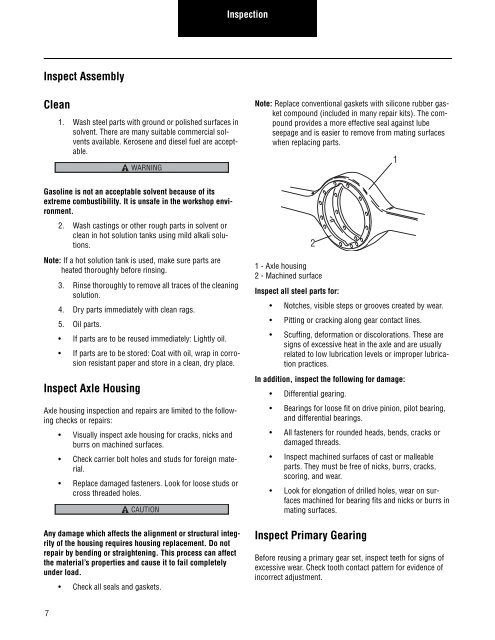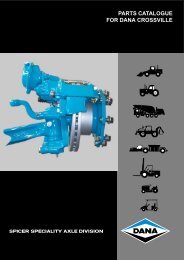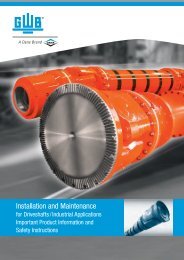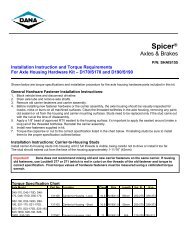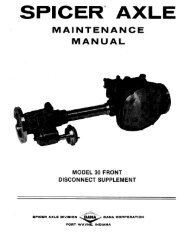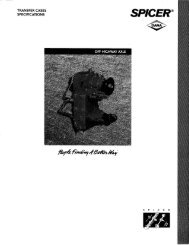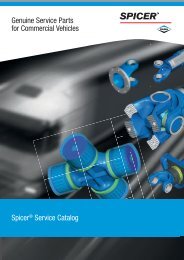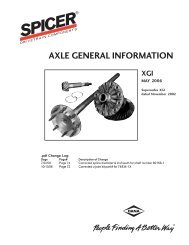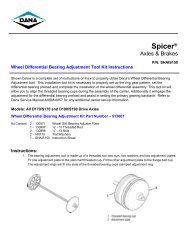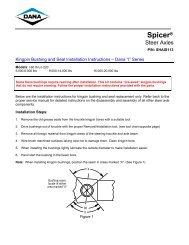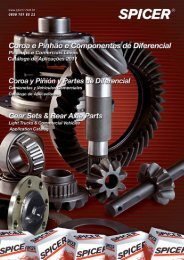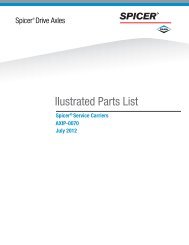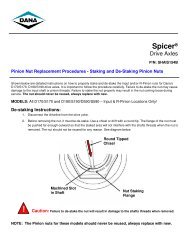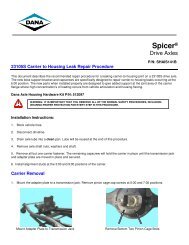Single Reduction & Single Reduction with Differential Lock - Spicer
Single Reduction & Single Reduction with Differential Lock - Spicer
Single Reduction & Single Reduction with Differential Lock - Spicer
Create successful ePaper yourself
Turn your PDF publications into a flip-book with our unique Google optimized e-Paper software.
Inspect Assembly<br />
Clean<br />
7<br />
1. Wash steel parts <strong>with</strong> ground or polished surfaces in<br />
solvent. There are many suitable commercial solvents<br />
available. Kerosene and diesel fuel are acceptable.<br />
Gasoline is not an acceptable solvent because of its<br />
extreme combustibility. It is unsafe in the workshop environment.<br />
2. Wash castings or other rough parts in solvent or<br />
clean in hot solution tanks using mild alkali solutions.<br />
Note: If a hot solution tank is used, make sure parts are<br />
heated thoroughly before rinsing.<br />
3. Rinse thoroughly to remove all traces of the cleaning<br />
solution.<br />
4. Dry parts immediately <strong>with</strong> clean rags.<br />
5. Oil parts.<br />
If parts are to be reused immediately: Lightly oil.<br />
If parts are to be stored: Coat <strong>with</strong> oil, wrap in corrosion<br />
resistant paper and store in a clean, dry place.<br />
Inspect Axle Housing<br />
WARNING<br />
Axle housing inspection and repairs are limited to the following<br />
checks or repairs:<br />
Visually inspect axle housing for cracks, nicks and<br />
burrs on machined surfaces.<br />
Check carrier bolt holes and studs for foreign material.<br />
Replace damaged fasteners. Look for loose studs or<br />
cross threaded holes.<br />
CAUTION<br />
Any damage which affects the alignment or structural integrity<br />
of the housing requires housing replacement. Do not<br />
repair by bending or straightening. This process can affect<br />
the material’s properties and cause it to fail completely<br />
under load.<br />
Check all seals and gaskets.<br />
Inspection<br />
Note: Replace conventional gaskets <strong>with</strong> silicone rubber gasket<br />
compound (included in many repair kits). The compound<br />
provides a more effective seal against lube<br />
seepage and is easier to remove from mating surfaces<br />
when replacing parts.<br />
2<br />
1 - Axle housing<br />
2 - Machined surface<br />
Inspect all steel parts for:<br />
Notches, visible steps or grooves created by wear.<br />
Pitting or cracking along gear contact lines.<br />
Scuffing, deformation or discolorations. These are<br />
signs of excessive heat in the axle and are usually<br />
related to low lubrication levels or improper lubrication<br />
practices.<br />
In addition, inspect the following for damage:<br />
<strong>Differential</strong> gearing.<br />
Bearings for loose fit on drive pinion, pilot bearing,<br />
and differential bearings.<br />
All fasteners for rounded heads, bends, cracks or<br />
damaged threads.<br />
Inspect machined surfaces of cast or malleable<br />
parts. They must be free of nicks, burrs, cracks,<br />
scoring, and wear.<br />
Look for elongation of drilled holes, wear on surfaces<br />
machined for bearing fits and nicks or burrs in<br />
mating surfaces.<br />
Inspect Primary Gearing<br />
Before reusing a primary gear set, inspect teeth for signs of<br />
excessive wear. Check tooth contact pattern for evidence of<br />
incorrect adjustment.<br />
1


